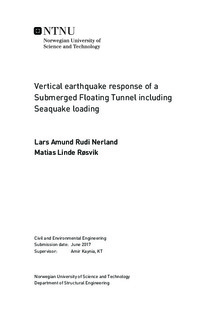Vertical earthquake response of a Submerged Floating Tunnel including Seaquake loading
Master thesis
Permanent lenke
http://hdl.handle.net/11250/2454951Utgivelsesdato
2017Metadata
Vis full innførselSamlinger
Sammendrag
This MS thesis investigates vertical seismic response in time domain on the proposed concept for a SFT with vertical tension leg design located at Bjørnafjorden. A 3D beam model is employed to conduct seismic analysis on the SFT by applying three vertical earthquake acceleration time series normalized to local peak ground acceleration. The hydrodynamic properties of the SFT is applied according to numerical results from an analysis in the hydrodynamic software WADAM. A simplified sensitivity study is conducted on relevant effects for the structural response. Emphasis was given to investigate the load effect known as seaquake, originating from the propagation of primary waves in water due to seabed ground motion. Seaquake loading was calculated in a decoupled approach both analytically in frequency domain and numerically in time domain through a finite element analysis in ABAQUS.
The results show that seaquake loading resulted in only a modest increase in peak tether stresses, but a large amplification in accelerations. The seaquake effect is still somewhat uncertain as no structural coupling was introduced. The results show that vertical earthquakes of 475-year return period is not of critical importance to the SFT, while considering earthquakes of 10 000-year return period may lead to a too low safety margin for the tether stresses in the stiffest tether group.
